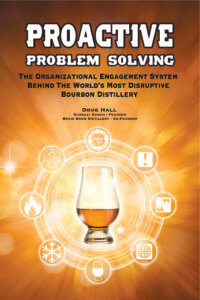Doug Hall isn’t interested in putting out fires. He’s focused on eliminating the spark.
As founder of Eureka! Ranch and Brain Brew Distillery, Hall has helped organizations rethink how they approach problems—before they become crises. With roots as a chemical engineer and a rapid rise to Master Marketing Inventor at Procter & Gamble, Hall’s journey led him to a career studying why teams waste time, lose focus, and stall innovation.
In his new book, PROACTIVE Problem Solving, he highlights a tough truth: managers can spend up to 3.5 hours a day fixing issues created by broken systems. Meanwhile, only a third of employees say they feel engaged at work.
His solution? A simple, repeatable system: Define Problems. Create Solutions. Drive Out Risk. That formula has powered more than 20,000 innovations and helped companies like Nike and Disney reimagine what’s possible. It also helped Brain Brew ship over 100,000 cases of Bourbon in just six years.
In our conversation, Hall pulls back the curtain on what really holds teams back—and what to do about it. From calling out “stupid” systems to embracing failure, his approach is as practical as it is powerful.
In your book PROACTIVE Problem Solving, you highlight that only 32% of employees feel actively engaged, and managers waste up to 3.5 hours daily dealing with flawed systems. What do you see as the primary factors contributing to such widespread disengagement and inefficiency?
The root cause of the 3.5 hours of wasted time each day is a lack of understanding of the power of a system-thinking mindset. As Dr. W. Edwards Deming taught, 94% of problems are because of the system, 6% because of the worker. Sadly, thinking of problems as being caused by a system of interconnected parts is not taught in schools or in organizational training. Instead the accepted behavior is to find someone to blame for the problem. Workers know this. They know that when things go wrong – someone will be blamed. As a result, they avoid speaking up about problems as it could cause them to be blamed.
You emphasize the need to “STOP THE STUPID” work systems. Could you share an example of a particularly “stupid” system you’ve encountered, and how proactive problem solving transformed it?
When after a day of work your hands ache – then you are a victim of a “stupid” work system.
When you get hurt at work – it is likely that you are a victim of a “stupid” work system.
When you have to use “work arounds,” it is likely that you are a victim of a “stupid” work system.
“Stupid” work systems are repeatable, reliable challenges that get in the way of you doing meaningful work.
A classic example, from a recent PROACTIVE Problem Solving workshop run by our Eureka! Ranch team, was presented by a woman employed at a commercial equipment manufacturer.
When asked for “stupid” things she faces, she said “my back hurts.” Asked why, she replied, “It hurts from lifting the machines into the boxes for shipping.” Discussion with others from her team found she was not alone in her back pain.
Using the tools taught in my book PROACTIVE Problem Solving, they created potential solutions. After some experimentation, the team leader moved to a different kind of box that was designed to be built around the machine instead of the box being assembled then the machine lifted into it. Voila. No lifting. No back pain. No more “stupid”.
The book outlines three sections: Defining Problems, Creating Solutions, and Driving Out Risk. Why did you choose this structure, and how do these components interconnect to enhance problem-solving effectiveness?
My goal with the PROACTIVE Problem Solving book was to make the teachings as simple and easy to understand as possible. My other books contain up to 150,000 words each. PROACTIVE Problem Solving is 50,000 words. Compressing the book’s message into a third of the words required me to change how I wrote. Each chapter was written and rewritten to be as simple and clear as possible. The result is a book that is more accessible by more people.
The three sections create a simple three-step process. 
Defining PROBLEMS teaches how to identify problems. The process involves defining not only WHAT the problem is but also WHY it’s important to solve. WHAT gives clarity to the challenge. WHY provides motivation to find a solution.
Creating SOLUTIONS teaches a system that everyone can use to discover fresh ideas. It starts with feeding your brain with a learning Stimulus that creates sparks you can build off. It expands by seeking out Diversity of viewpoints from your work team, friends, and others who look at the stimulus and see fresh connections.
Diving Out RISK – teaches how to use fast learning cycles to increase your confidence as you reduce risk. The method is called the Deming cycle. It is was developed by Dr. Deming when he taught the Japanese following WWII how to use system thinking to increase their manufacturing quality. Each Plan, Do, Study, Act (PDSA) learning cycle involves four steps:
PLAN – What is your idea for solving your problem.
DO – Run an experiment – as small and as fast as possible to learn if the solution works.
STUDY – Think deeply about why the solution didn’t work or why it did work.
ACT – Based on study, adopt the change, revise your Plan and do another cycle or archive the problem for now.
Informally, students of PROACTIVE Problem Solving, call PDSA Fail FAST Fail CHEAP with the emphasis on FAST and CHEAP. Cycles of learning often involve, formal experiments, rapid prototypes, doing the math on impact and cost and experimentation.
In the Defining Problems section, you stress the importance of asking “What” and “Why” questions. How can organizations cultivate a culture where employees feel empowered to question existing processes?
Empowering employees requires growing their Capability and Confidence. Capability is built through training, teaching and coaching. Confidence comes with experience completing the process by Defining Problems, Creating Solutions, and Driving Out Risk.
Drawing from your experience at Brain Brew Distillery, which grew to over 100,000 cases annually in six years, what were some key problem-solving strategies that facilitated this rapid expansion?
Key problem-solving strategies that helped Brain Brew adapt and adjust as it grew included:
A Culture of Learning – From the front line to leadership, we have developed a culture of continuous learning. The learning stimulates fresh ideas for working smarter. Areas we use for mining learning include: our vendors, on-line discussion boards of craft distilleries as well as internet searches.
A Culture of Collaboration – The learning we gather is exponentially multiplied through Create sessions where team members bring their unique perspective to the stimulus and the challenge.
A Culture of Experimentation – When we discover a solution to our problem, we create and execute fast and cheap experiments to help us learn if the solution works or if more thinking is needed.
The book discusses transforming good ideas into game-changing results by decreasing risk. What are some common pitfalls organizations face when attempting to implement new ideas, and how can they be mitigated?
The keys to successfully implementing new ideas are clarity and communications. Clarity involves documenting in writing the revised Standard Operational Procedures for the new idea. Communications involves training everyone involved in the new system.
With over 20,000 innovations developed at Eureka! Ranch for companies like Nike and Disney, what patterns have you observed in organizations that successfully adopt proactive problem-solving methods?
 Creating a proactive culture is challenging. The best practice we’ve found is to simultaneously engage the organization from the top down, bottom up, and middle out. It often starts with a Plan, Do, Study, Act cycle that involves a set of volunteers from the company attending a one-day PROACTIVE Problem Solving workshop. This activation provides insight into customizations that can be made to the workshop to make it align with the unique needs of the culture.
Creating a proactive culture is challenging. The best practice we’ve found is to simultaneously engage the organization from the top down, bottom up, and middle out. It often starts with a Plan, Do, Study, Act cycle that involves a set of volunteers from the company attending a one-day PROACTIVE Problem Solving workshop. This activation provides insight into customizations that can be made to the workshop to make it align with the unique needs of the culture.
The second step involves half or full day workshop for a sample of leaders and managers. The program details not only what will be taught to team members but also what the managers and leaders roles are in transformation of the culture.
Based on learning from the PDSA cycles with team members, managers and leaders, the training program is customized to the organization. Sometimes this involves adapting language to align with existing nomenclature. It often involves incorporating existing success stories of PROACTIVE Problem Solving across the organization before the training had begun. This is done to help all attendees see clearly how what is being trained is in alignment with and effective for the organization and its challenges.
Reflecting on your journey from Procter & Gamble to founding Eureka! Ranch and Brain Brew Distillery, how have your personal experiences shaped the methodologies presented in PROACTIVE Problem Solving?
The more I’ve learned over the past fifty years of innovating, the more certain I am that I have lots to learn. I teach that the secret to becoming a great problem solver is to accept publicly that:
- Don’t Know,
- I Need Help, and
- I Fail A Lot.
When you do, you open your mind to fresh ideas, perspectives and solutions.
For more information see PROACTIVE Problem Solving.
Image credit: Marija Zaric


